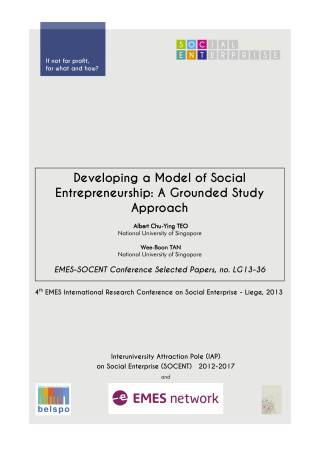Within the past decade, much has been written on the topic of social entrepreneurship. However, the extant social entrepreneurship literature is predominantly either conceptual (e.g., Alter, 2006; Nicholls and Cho, 2006; Peredo and McLean, 2006; Praszkier and Nowak, 2012; Weerawardena and Mort, 2006), instructional (e.g., Dees, Emerson and Economy, 2001; Dees, Emerson and Economy, 2002; Jager, 2010; London and Morfopoulos, 2010) and/or documental of case studies of outstanding social entrepreneurs and social enterprises (e.g., Bornstein, 2007; Elkington and Hartigan, 2008). This study offers an empirical contribution to social entrepreneurship theory building by engaging in inductive research.
Given the inductive nature of this study, grounded methodology (Glaser and Strauss, 1967) is used to develop fresh theoretical ideas and perspectives on social entrepreneurship. In particular, the concept-indicator model of theory development proposed by Glaser (1978) is adopted. This model encompasses 4 stages: (1) comparing incidents applicable to each category; (2) integrating categories and their properties; (3) delimiting the theory; and (4) writing the theory.
For this study, in-depth interviews are conducted with ten social entrepreneurs who currently manage their respective social enterprises in Singapore. During the interviews, the social entrepreneurs discuss their motivations, their personal backgrounds, and their perspectives on social entrepreneurship, the social enterprise sector and the social enterprises that they run. The interviews are transcribed, and the contents are critically analyzed and open coded into conceptual categories (Glaser, 1978). Each of these categories assigns a common meaning to multiple data observations (Locke, 2001). These conceptual categories are then further evaluated against data observations through selective coding and integrated with other categories to make further progress in the theory development (Glaser, 1978). The analysis eventually comes to a close when the theory ‘solidifies’ (Glaser and Strauss, 1967), and each category reaches the point of saturation where “subsequent data observations result in no new naming activity” (Locke, 2001).
The form of each interview is semi-structured (Ghauri, Gronhaug, & Kristianslund, 1995). While a fixed set of guiding questions are posed, the actual flow of the interview is open-ended in nature and allows for free responses. The interviews follow the guiding principles of grounded methodology (Glaser & Corbin, 1967; Strauss & Corbin, 1998; Goulding, 2002), such as open sharing, reduced rigidity and minimal guiding. Open-ended questions are used as much as possible to allow generation of unguided answers.
Analysis of the interview transcripts yields seven observations. These seven observations are then integrated to yield five concepts. And these five concepts are in turn further reduced to three key propositions:
- Proposition 1: The motivation for social entrepreneurship is to address existing social gaps.
- Proposition 2: Social entrepreneurship is about creating opportunities to achieve social missions.
- Proposition 3: The desired results of social entrepreneurship are social awareness and empowerment within the community.
A process model of social entrepreneurship can be developed from the three propositions (see the figure below). This model highlights the circularity of the process, from the initial motive of embarking in social entrepreneurship, to its course of action, and finally to the resultant outcome which generates more social entrepreneurial motives.



